
Art Anthropology of Oranges and Humans (Part 2)
-After the “Mikan Mandala” Exhibition-
2. Beyond the Boundary Between Oranges and Humans
(1) Harvest / A Journey of Fruits
Part of our latest exhibition took place at Yui Warehouse, which is adjacent to the Akitsuzuno Farmer’s Market Kitera, jointly established by local farmers to sell locally grown citrus fruits and various processed products. This place, where fruits grown by local producers are collected, processed and sold, can be said to be one of the “ends” of fruits. However, I think that “a journey of orange (or citrus)” does not end here when we eat it. Rather, it is the “beginning” of the extensive circulation and flow of living organisms, including humans, through the body.
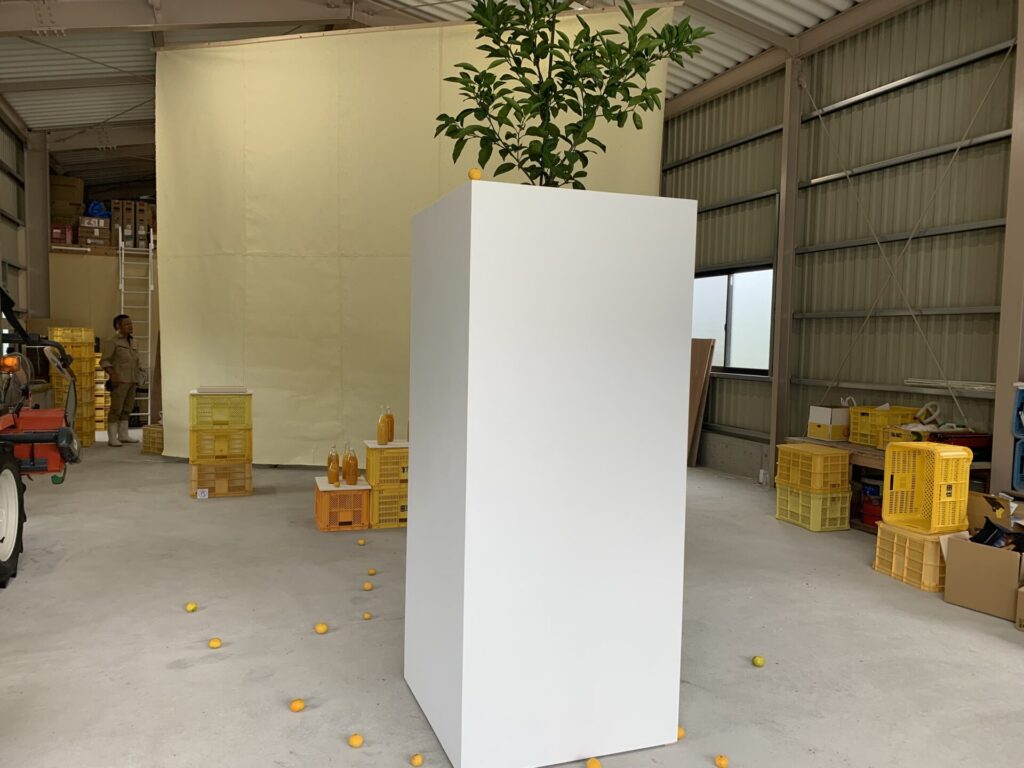
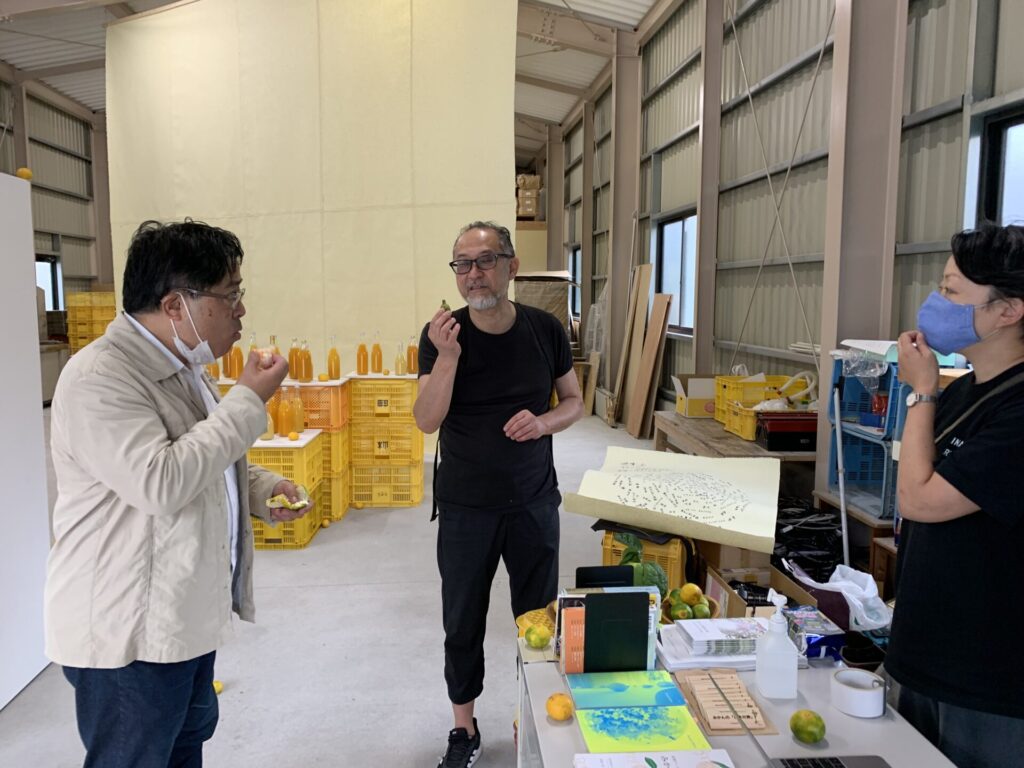
Anthropologist Tim Ingold (1948-) defines ‘animacy’ as ‘the unbroken living flow of things before the dividing line between mind and things,’ and states that living is a continuum of generation that sets no boundaries” [Okuno, Yamaguchi, Kondo 2012: 52, 53]. In other words, “to be alive” is to place oneself in the movement of living organisms and to participate as material in a fluid world where there is no “beginning” or “end” [Ingold 2021: 167-171].
Humans and oranges continue to circulate as living beings. A good example of this is eating food. “Eating” is an act of trying to dissolve the boundary between “food to eat” and “food to be eaten”. For us, eating is always meeting other living things and we are forced to live by consuming the lives of others. It means to inject the life of another into one’s own body [Coccia 2022:97]. Based on this, the “death” of being eaten as a fruit does not mean the end of a single organism, but instead means becoming part of a new life. At the Yui warehouse, seasonal oranges were distributed to the viewers, and we experienced the citrus aroma that prevailed in the venue. By consuming oranges, we take in the ‘living’ of it, which creates an experience that dissolves the boundary between ‘humans’ and ‘oranges.’

At the venue, Hirose exhibited “il giardino dei sensi” using citrus fruits, and a paper installation recycling the skins of thinned mandarin oranges which are usually thrown in the orchard field. According to Mancuso, humans have hitherto placed the existence of plants at the bottom of the hierarchy [cf. Mancuso 2015:32-34]. In “il giardino dei sensi,” however, the orange tree was able to look down on us, being set up in a wooden box higher than a human being. I think Hirose was trying to turn the relationship between “humans” and “oranges” upside down (or perhaps equalize it). This could be something opposite from what the local farmers experience since they maintain the height of the orchards for productional reasons. So, Hirose captured a reversed experience outside of the ordinary view a farmer might have.
In Japanese haiku culture, “seasonal words” are always required, as it is said that such words allow thinking from a non-human perspective [Nakazawa, Ozawa 2016: 16]. “Il giardino dei sensi” may have been a modern expression of this. Given this context, I think that Hirose’s work is something like a medium for exchanging the viewpoints of mandarin oranges and humans.
In addition, another part of Orange Collective by Hirose used many types of orange juices collected from various local shops. These varied in color, turbidity, and even in bottle shape. Looking at the installation from a distance, I felt that I could find individuality in each “orange juice” which seemed to be displayed on the boundary between the natural and the artificial.
Citrus farmers thin the fruit of the citrus trees before harvesting it. So, Hirose tried to make paper out of the skins of the oranges that had been discarded and returned to the soil as a result of thinning. I’m perhaps not the only one who saw the paper as being exactly like the “carpet-like two-world mandala” that the artist Taro described.
Hirose’s all-yellow-green ‘Mikan Mandala’ seemed to match Taro’s ‘beauty of mandala’. Taro says that “a monochrome mandala is the right way to do it. Then, if there is only one color, as you look directly at it, you will be immersed in an infinite space. In a completely empty space, all kinds of image possibilities spring up and disappear infinitely, starting and unfolding from moment to moment. The monochrome of the mandala is not nihilism, it is an entry into a secret. It is a temporary means of absolute nothingness. It is intense because it is provisional” [Okamoto 2016: 238, 241]. Hirose’s “orange mandala,” like Taro’s work, is provisional. In this case, oranges, paper made by the orange skin, and mandarin orange juice are eaten, drunk, and distributed by local people, returning to the colorless and transparent mandala, that is, the world of “nothingness.”
Furthermore, Hirose has started a long-term project titled “A Journey to Seedlings of Oranges” at the exhibition. At the opening ceremony, Hirose and a local citrus farmer, Takuo Hara of Kishuhara Farm gave a brief talk session. Hara is the 7th generation owner of a farm in Kamiakizu, Tanabe City, that has been around since the late Edo period. In particular, Hara is interested in the diversity and deep history of citrus fruits, and cultivates about 60 varieties of citrus fruits, including not only the latest varieties, but also rare varieties called original varieties, and old varieties rooted in the region. He is a citrus farmer who connects citrus cultivation technology and citrus culture. Hirose and Hara will grow mandarin orange seedlings together with foster parents living in Kinan. And in the future we will create new farmland as a “commons farm” (a farm land for everyone that can be used by anyone), and rethink the concept of sharing though the “shared farmland.”
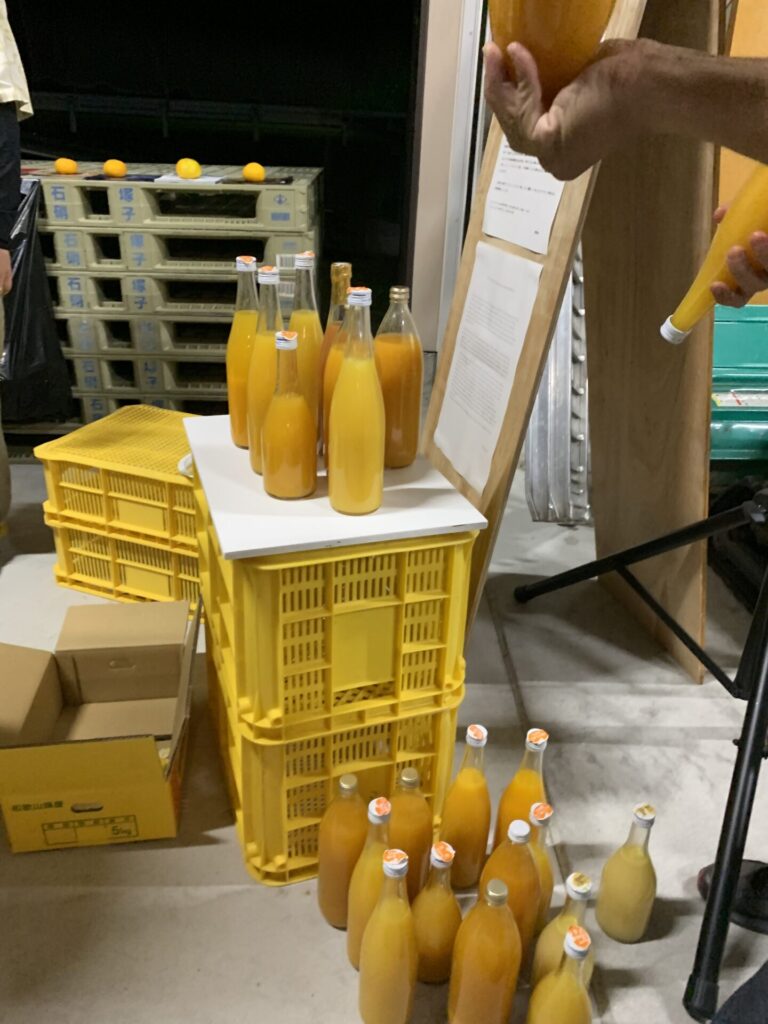

I noted that the orange mandala will return to nothing, but pure gifting is a gift supported by “nothingness,” and a society of gifting is a society driven by “nothingness” [Nakazawa] 2004:285]. The development of a “Commons Farm” is a long-term project that transcends market principles and capitalism, based on donations supported by “pure gifting” beyond destruction and consumption. I hope that this place will nurture Nakazawa’s symmetrical thought, incorporating logical contradictions while performing a general overall operation from the underlying part of the mind.


(2) Soil and Roots / Exploring Invisible Roots
In 1957, Eiichi Tauchi built the Ryokan, “Aiwaso” in Furuo, Tanabe City on the ruins of Uenoyama Castle, to further cultural development of the city. Currently, it operates as an inn using the same private Ryokan, taking over that name. Here, we focused on the soil that creates richness, looking at the roots and soil in the ground from Aiwaso, a place overlooking Tanabe City and Tanabe Bay.
At the venue, works by Satoshi Hirose, Khvayi Samnang from Cambodia, and works by the collective “Bacilli” formed by three artists, James Jack/Yoshiki Nanjo/Shotaro Yoshino, were exhibited.


Hirose’s new work “Kumano Radici” is composed of sculptures and photographs with motifs of nature and tree roots that he felt while walking the Kumano Kodo. In particular, he has been thinking about how to capture the “root” that has an invisible existence.
It was surprising to see the unexpected “lightness” of the roots that appeared in front of us, and eye-opening to observe those roots from multiple angles, or look up at it. Also, in the photographic work, are the roots growing towards the underground or in the celestial direction? If it is true that, as Emanuele Coccia stated in “The Philosophy of Life in Plants (2019)” that, “The root is an astral body [Coccia 2021]” (which overlaps with what Taro Okamoto calls Kumano’s “reversed-world” [Okamoto 2015: 142]), then Hirose’s work was well presented.
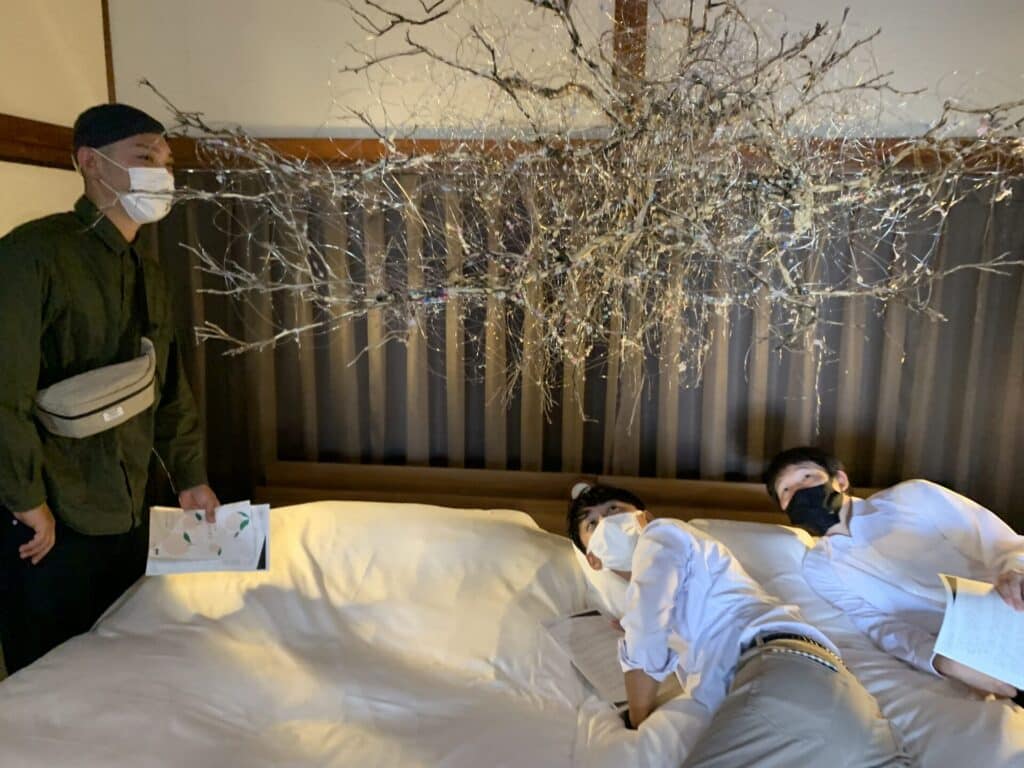

Cambodian artist Khvay Samnang (1980-) creates a new perspective on current local political issues by utilizing symbolic gestures of traditional cultural rituals and history. “Untiled 2011” shows Bong Kak Lake under property development. In Phnom Penh, since 2008, accelerated land development has resulted in Boeong Kok Lake and several other major lake areas being filled with soil brought from outside to build buildings. On the other hand, ironically, Cambodia’s soil is exported to Singapore and other developed countries for landfill use. I think his message is that we must not forget that the soil that constructs the “place” is also constantly moving.

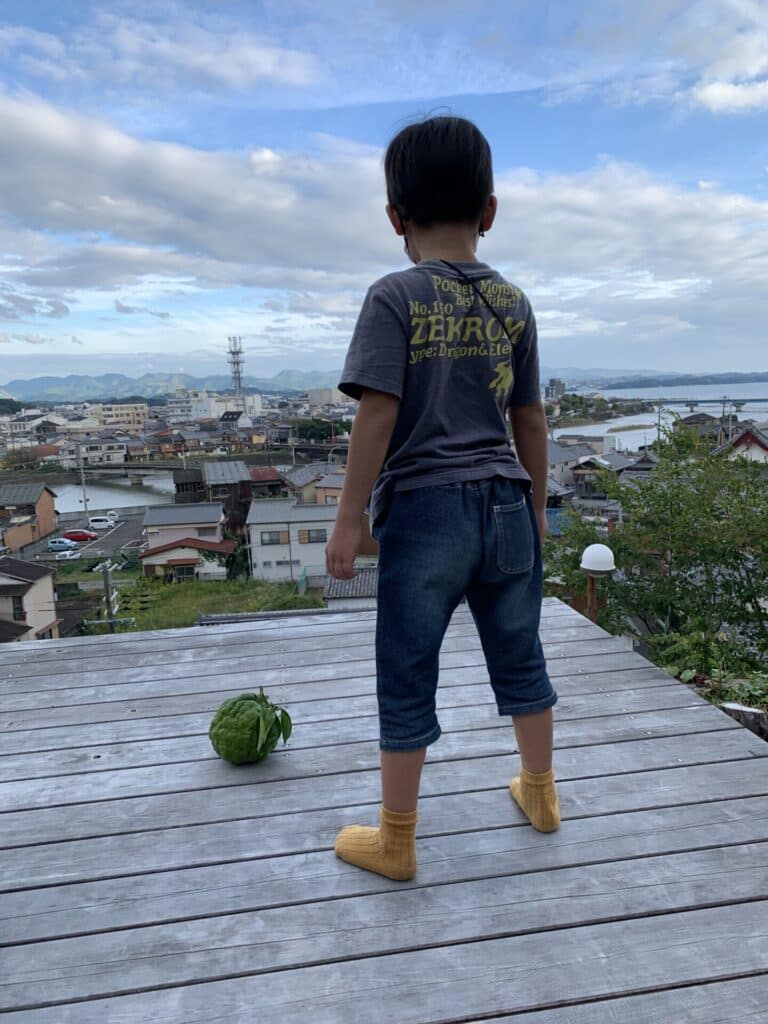
The soil-related issues, Samnang argues, cause low-income earners to be pushed out of the lakes, and cause flooding and pollution of rivers during the rainy season to occur more often. All of this being a cause of overconsumption of land by the well-off. This issue is not limited to Phnom Penh but also arises in other developing countries. With this in mind, while looking at the beautiful scenery of Tanabe Bay from Aiwaso over the screen of Samnang’s performance pouring soil over his head, I was made to wonder about how and by whom, Tanabe, a part of Kinan, has been shaped since ancient times.
On October 7th, we invited art anthropologist Toshiaki Ishikura to hold a talk session with Khvay Samnang titled “Memories of Soil and Roots: From Cambodia and Kinan/Kumano.” Prof. Ishikura has traveled throughout India and Japan, researched Japanese legends, folklore and myths, and has published many research papers. Throughout the dialogue, hidden memories, commonalities and differences between stories and myths of Cambodia and Kinan were brought to light.
As the French philosopher Simone Weil (1909-1943) said, the most fundamental need for people is to have their own roots and soil [Weil 2010: 64]. Using Samnang’s work as a starting point, they discussed the roots and soil of Cambodia and Kinan through the differences and similarities between Cambodian and Kumano mythology, Western dance and Eastern dance, and plant and animal expressions. From Samnang’s words, poetry, and dance, I was able to intuit that he did not separate plants and animals, spirit and matter, etc., and that mythical thinking that transcends the law of contradiction is at the foundation of Samnang’s work and how his expressions are constructed. I think it was a deeply meaningful experience to take in. Samnang’s improvisational poetry and dance performed during the talk made me feel “something” beyond words and languages connected to the land of Kumano.

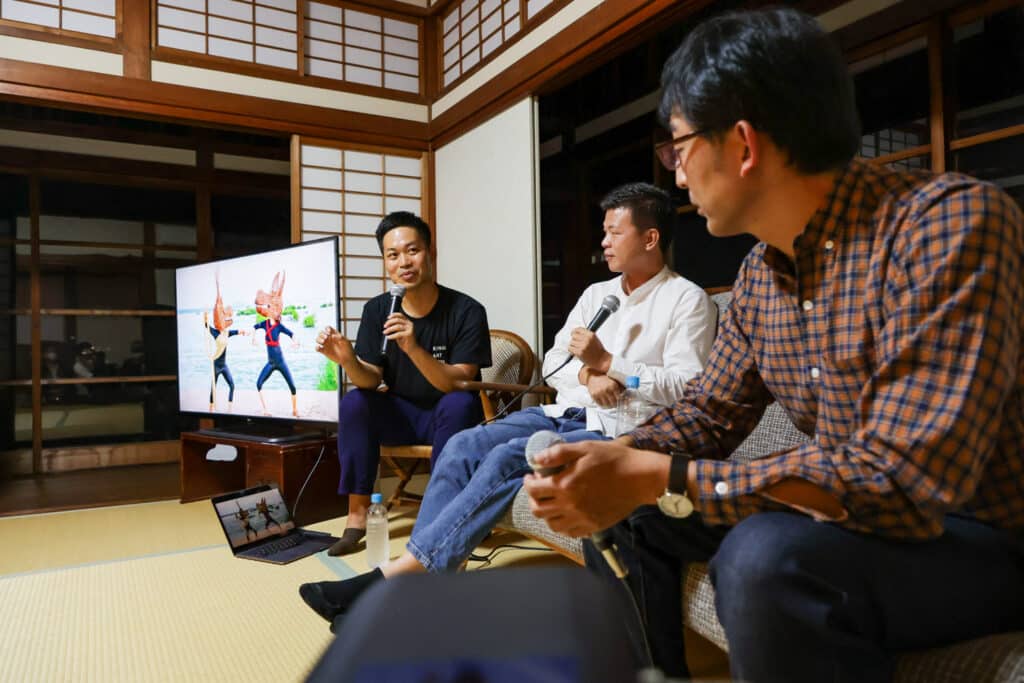
Bacilli is an art collective that focuses on dirt, people, food, microbes and spirits. The word “bacilli” means one of the classifications of organisms that grow in the dirt, and refers to common germs and bacteria such as fungi and blue-green algae. The collective creates spaces and environments that connect these microorganisms with humans. Bacilli’s activities are characterized by trying to revive the story of the dirt, as if the memory of a place is rooted in the ground.
At the exhibit, Bacilli’s Nanjo, based in Kinan, centered around a collaboration with Chef Ryosuke Sarai of Tanabe’s French restaurant “Caravansarai” to open a special one-day restaurant called “Dirt Restaurant.” On October 14th, we held a dinner party titled “Fragrant Soil”, where we crossed the boundary between fruit and soil with local people to discuss “What is eating?”, “What is agriculture?”, “What is soil?”, and “What is place?”
In addition, we enjoyed the soil of citrus farms from various areas in Tanabe City such as Maro and Kamihaya, along with fruits and roots, and tasted the differences not only through our senses of sight but also through our senses of smell and taste. In 2023, Bacilli is planning to show the video recording of the event and at the same time hold casual citrus dinner parties and workshops.

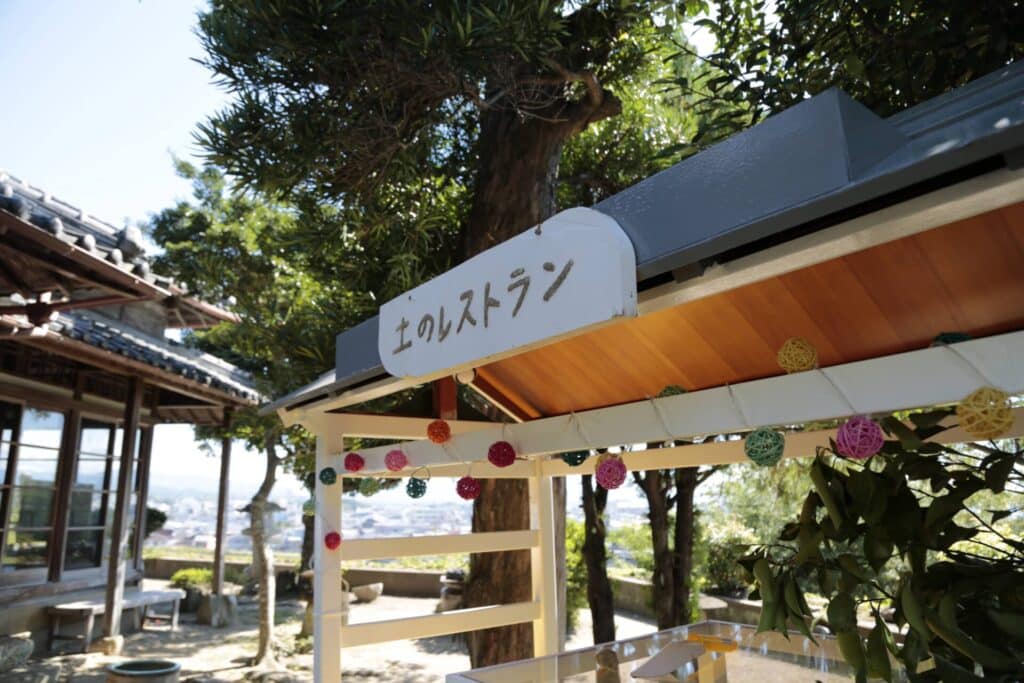
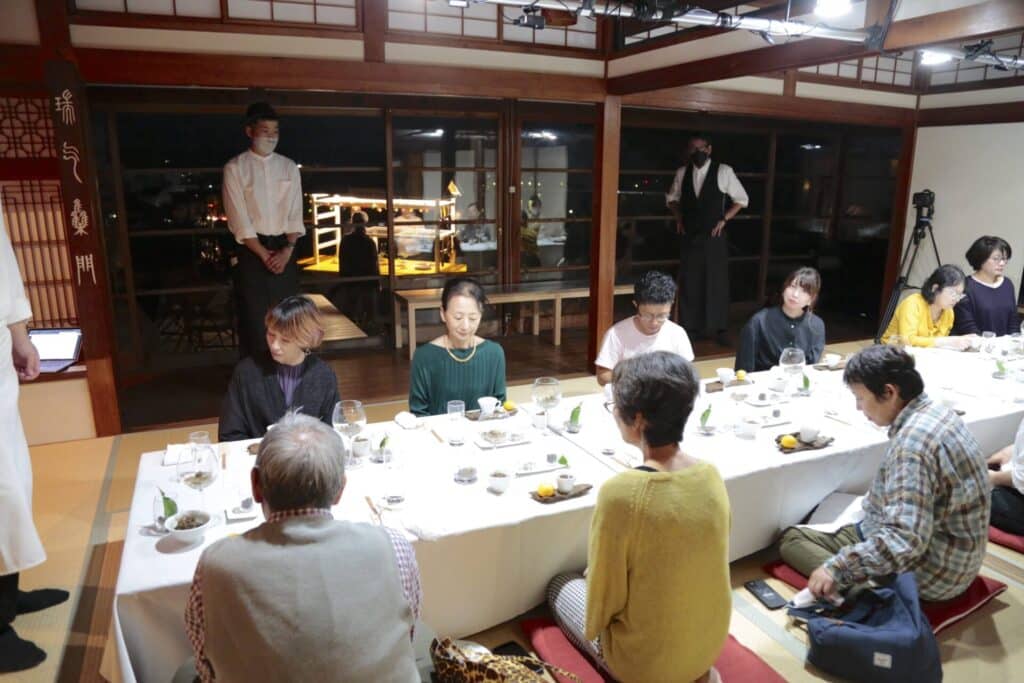
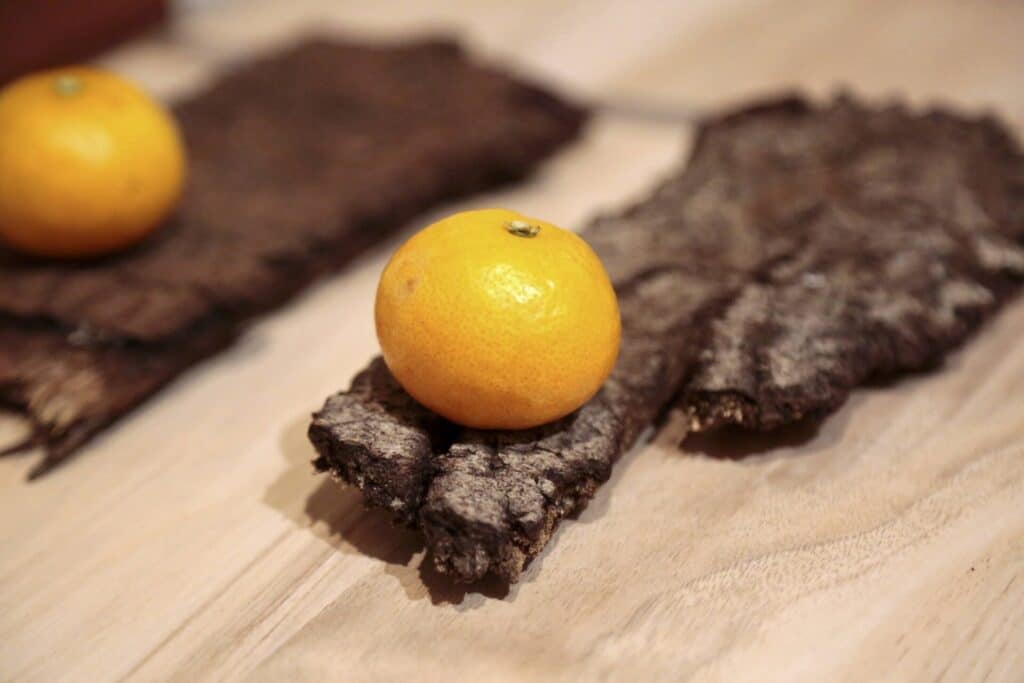
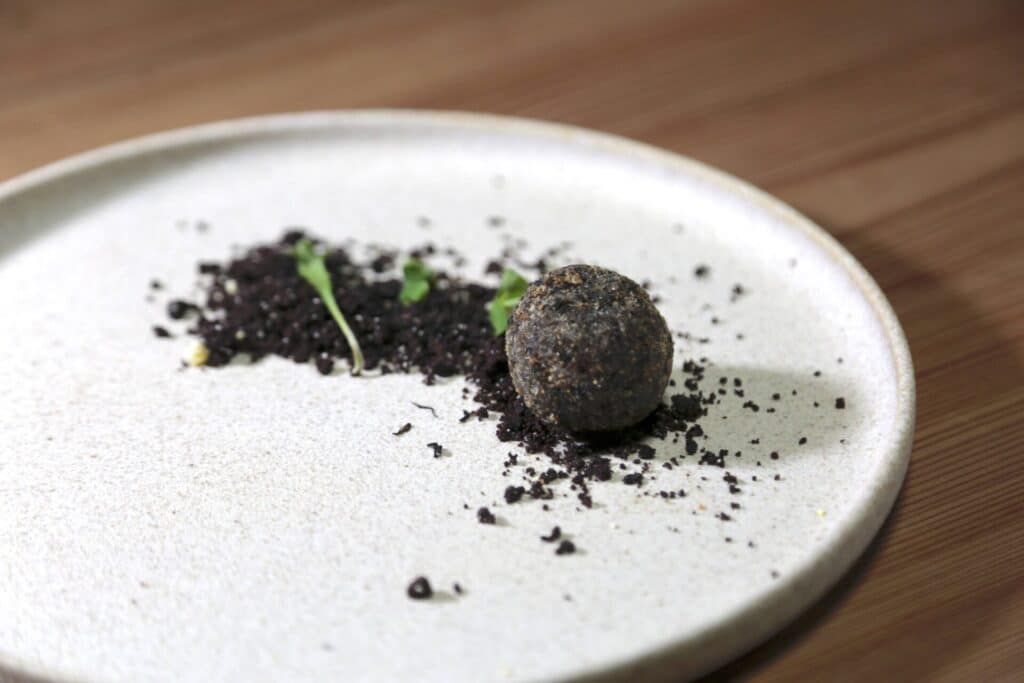
<Reference list>
・Ando, Reiji. “Jomon Theory.” Sakuhinsha. 2022. [Translated from Japanese.]
・Bourriaud, Nicoas. ”Radicant. Pour une esthétique de la globalisation.” Translated by Hironari Takeda. Film Art. 2022.
・Burgat, Florence. “Qu’est-ce qu’une plante ? – Essai sur la vie végétale.” Translated by Yuko Tanaka. Kawakado Shinsha. 2021.
・Coccia, Emanuele. “Plant Life Philosophy: A Mixed Metaphysics.” Keiso Shobo. 2019. [Translated from Japanese.]
・Coccia, Emanuele. “Philosophy of Metamorphose.” Keiso Shobo. 2022. [Translated from Japanese.]
・Fujihara, Tatsushi. “Thoughts on Plants.” Ikinobirubooks, Ikinobirubooks, 6 Sept. 2021. https://ikinobirubooks.jp/series/fujihara-tatsushi/378/.
・Hyman, Clarissa. “Orange History.” Hara Shobo. 2016. [Translated from Japanese.]
・Ingold, Tim. “Living Moves, Knows, Writes” Translated by Tetsushi Nakano, et al. Sayusha. 2021. [Translated from Japanese.]
・Ishikura, Toshiaki & Karasawa, Taisuke. “Anthropology of Viscera and Co-Mutants.” EKRITS, EKRITS, 24 Dec. 2020, https://ekrits.jp/2020/12/3980/. [Translated from Japanese.]
・Jung, Carl Gustav. “Individuation and Mandalas.” Misuzu Shobo, Ltd. 1991. [Translated from Japanese.]
・Miki, Shigeo. “Fetal World.” Chuko Shinsho. 1983. [Translated from Japanese.]
・Montgomery, David & Bikle, Anne. “The Hidden Half of Nature The Microbial Roots of Life and Health.” Translated by Natsumi Katooka. Tsukiji Shokan Publishing., Inc. 2016.
・Mori, Motonao. “Introduction to Anarchism.” Sjolima Shobo. 2017. [Translated from Japanese.]
・Nakazawa, Shinichi. “Gift of Pure Nature.” Serica Syobo, Inc. 1996. [Translated from Japanese.] ・Nakazawa, Shinichi. “Art Anthropology.” Misuzu Shobo, Ltd. 2006. [Translated from Japanese.]
・Nakazawa, Shinichi. “Symmetrical Anthropology,” Kodansha Ltd. 2008. [Translated from Japanese.]
・Nakazawa, Shinichi. “Jung and the Mandala.” Edited by The Japan Association of Jungian Psychology. 2010. [Translated from Japanese.]
・Nakazawa, Shinichi. “Oriental.” Kodansha Gakujyutu Bunko. 2012. [Translated from Japanese.]
・Nakazawa, Shinichi & Ozawa, Minoru. “Dive into the Sea of Haiku.” Kadokawa. 2016.[Translated from Japanese.]
・Mancuso, Stefano & Viola, Alesandra. “Verde Brillante―Senaibilità e Intelligenza del Momd Vegtale.” Translated by Koji Kubo. NHK Publishing, Inc. 2015.
・Okuno, Katsumi et al. “ Anthropology of Humans and Animals.” Shumpusha Publishing. 2012. [Translated from Japanese.]
・Okamoto, Taro. “Mysterious Japan.” Kadokawa Sophia Bunko. 2015. [Translated from Japanese.]
・Pierre Laszlo. “Culture of Citrus Fruits.” Translated by Tomoko Teramachi. Ittosha Incorporated. 2010. [Translated from Japanese.]
・Weil, Simone. “Having Roots (1)” Iwanami Shoten,Publishers. 2010. [Translated from Japanese.] Yabumoto, Yuto. “Orange Collective: From Mikan and Spiritual Traditions in the East, to the Orange in the Global Market.” Kinan Art Week, Kinan Art Week, 21 Feb. 2022, https://kinan-art.jp/en/info/5778/.
・Yabumoto, Yuto. “The Myth of the Orange.” Kinan Art Week, Kinan Art Week, 22 May 2022, https://kinan-art.jp/en/info/6987/.
・Yabumoto, Yuto. “The “Place” of Kinan -Modernism and Animism-.” Official Catalog for Kinan Art Week Exhibition 2021. Kinan Art Week. 2022.
・Yabumoto, Yuto. “Archived Text (First Half) of Kinan Chemistry Session Vol.2 ‘Seclusion and Openness: Kumagusu Minakata, the Giant of Knowledge and Contemporary Art.’” Kinan Art Week, Kinan Art Week, 13 July 2021, https://kinan-art.jp/en/info/937/.
・Yamamoto, Tetsuji. “Kojiki and the Theology of the Country: The Beginning of Japan and Place Myths.” EHESC. 2022. [Translated from Japanese.]
・Yoritomi, Motohiro. “Esotericism and Mandala.” Kodansha Ltd. 2014. [Translated from Japanese.]
